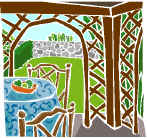|
|
|
|||||
|
|
||||||
|
||||||||||
|
Fast Growing Trees Fastest
Deciduous |
|
Faster
Deciduous |
|
Fast
Deciduous
Evergreen |
|
Fast Growing
Hedging Plants
Deciduous
Evergreen
Arborvitae
Douglas Fir |
Connected pages Patios and decks home | Planning a patio | How to build (lay) a patio | Planning a deck | How to build a deck | Structures |
|
|

The addition of a hard outdoor surface, whether deck or patio, increases living space considerably, and will greatly increase the usefulness of your garden. If you have any interest at all in spending time outdoors it really is almost as essential to a garden as plants are. A transition area between house and garden can become a part of both and can greatly extend the season when you can enjoy your garden after the hard work of gardening is done.
![]() The alternatives are wooden decks or stone patios.
Gravel doesn't really make a satisfactory surface to sit or play on, and while grass
can be perfect for both, for much of the spring and autumn, it will probably be
too wet and muddy to be pleasant to go on.
The alternatives are wooden decks or stone patios.
Gravel doesn't really make a satisfactory surface to sit or play on, and while grass
can be perfect for both, for much of the spring and autumn, it will probably be
too wet and muddy to be pleasant to go on.
![]() Hard surfaces are the most expensive form of
ground cover (more so than many fitted indoor floorings), so make sure you are
using all of the area usefully. Pots can be placed in corners where you are unlikely
to tread, but it seems a waste to me to put them on useful parts of the patio or
deck, you may have paid $50+ for the area your petunias are standing on.
Hard surfaces are the most expensive form of
ground cover (more so than many fitted indoor floorings), so make sure you are
using all of the area usefully. Pots can be placed in corners where you are unlikely
to tread, but it seems a waste to me to put them on useful parts of the patio or
deck, you may have paid $50+ for the area your petunias are standing on.
 The first
thought of a patio or deck is often of sitting out sunning yourself, gin & tonic
in hand while contenting yourself that you are master of all you survey (well at
least as far as the fence anyway). A little extra thought will give you an area
that can used more frequently.
The first
thought of a patio or deck is often of sitting out sunning yourself, gin & tonic
in hand while contenting yourself that you are master of all you survey (well at
least as far as the fence anyway). A little extra thought will give you an area
that can used more frequently.
The obvious position for a deck or patio is usually
immediately outside the patio
 doors
or back door of the house. This is convenient for many reasons, particularly if
you have small children so they feel close to the house when playing and can easily
be kept an eye on. Also, if you intend to eat al fresco very often and have barbecues
or parties outside, it’s easier to service these if the kitchen is nearby. Bear
these in mind if you are thinking of an area away from the house.
doors
or back door of the house. This is convenient for many reasons, particularly if
you have small children so they feel close to the house when playing and can easily
be kept an eye on. Also, if you intend to eat al fresco very often and have barbecues
or parties outside, it’s easier to service these if the kitchen is nearby. Bear
these in mind if you are thinking of an area away from the house.
![]() As an absolute minimum 10ft x 10ft square (3m)
will allow you to get a small round table and 4 chairs with a bit of elbow room.
3m x 5m (10ft x 15ft) is more realistic for a family with one or two children or
a couple who like to entertain. If you go larger than this, pay more attention to
how the area fits in with the rest of the garden. Is it beginning to dominate? Is
privacy becoming more of an issue?
As an absolute minimum 10ft x 10ft square (3m)
will allow you to get a small round table and 4 chairs with a bit of elbow room.
3m x 5m (10ft x 15ft) is more realistic for a family with one or two children or
a couple who like to entertain. If you go larger than this, pay more attention to
how the area fits in with the rest of the garden. Is it beginning to dominate? Is
privacy becoming more of an issue?
Sun, shade, shelter from wind & privacy
These are the other major considerations.
It’s better to have a sunny patio than one in the shade as you can always make shade but you can’t make sun!
than one in the shade as you can always make shade but you can’t make sun!
Remember that sitting in direct sunshine in summer can be uncomfortably hot. Parasols can provide an elegant solution and have the advantage of being removable when the sun doesn’t shine. Another solution is something to give dappled shade, a pergola with trellis as a roof, or my preference - climbers supported with wires, give a nice effect. Ideally, to extend the season of use there should be some possibility of shade in mid-summer, but not in spring and autumn when the sun is warm without being overpowering, deciduous climbers can help here.
Avoid most trees near your patio or deck, exceptions
are those with a light open canopy such as
birches (Betula spp.)
and
Robinia
pseudoacacia “frisia”, though be wary of these being too close to the house.
Most other trees would give too dense a shade. Almost any tree planted within 1-2m
will in time begin to lift your patio with its roots, decks are not affected in
the same way and can be constructed around the base of existing trees.
 Shelter
from wind is also very important when sitting your deck / patio, if everywhere seems
to be windy, consider erecting a pergola screen for protection. 6ft x 6ft trellis
panels held up by 3” square posts are effective and you can plant climbers at the
base of the trellis to soften the effect. Trees, a hedge, or large shrubs on the
windward side of the garden can also help considerably to curb the wind. An extra
2 ft of trellis on top of a boundary fence is also very effective (and doesn't usually
need the planning permission that a taller fence might).
Shelter
from wind is also very important when sitting your deck / patio, if everywhere seems
to be windy, consider erecting a pergola screen for protection. 6ft x 6ft trellis
panels held up by 3” square posts are effective and you can plant climbers at the
base of the trellis to soften the effect. Trees, a hedge, or large shrubs on the
windward side of the garden can also help considerably to curb the wind. An extra
2 ft of trellis on top of a boundary fence is also very effective (and doesn't usually
need the planning permission that a taller fence might).
![]() Decks should really only be positioned where they
are in the sun for most of the time. If too shaded, they remain wet and slippery
(or at least more slippery than when dry) for longer, which will also reduce the
life of the wood. Patios are better for shady places and whereas wet wood can look
rather dreary, wet slabs / bricks aren’t so bad.
Decks should really only be positioned where they
are in the sun for most of the time. If too shaded, they remain wet and slippery
(or at least more slippery than when dry) for longer, which will also reduce the
life of the wood. Patios are better for shady places and whereas wet wood can look
rather dreary, wet slabs / bricks aren’t so bad.
![]() Cost
– varies greatly, make sure you know what slabs / bricks or wood you are getting
before you commit.
Cost
– varies greatly, make sure you know what slabs / bricks or wood you are getting
before you commit.
|
Decks and patios can be installed by the competent (important word that) DIY'er. They are not for beginners, they are major projects and often hard heavy work. Make sure you know what you're taking on before you start, that you have the right tools, that you are carrying the work out to the correct standards and that you are using the right materials. There are many sources of information on the construction of decks and patios. You are strongly recommended to consult a specialist source of information. Unless you are particularly confident (and fit) leave a patio to the professionals. A patio needs to be dug out to a depth of around 15cm, that’s 2.25 m3 of soil to be dug out for an average 3m x 5m area, and it won’t always come up easily. What comes out has to be disposed of and then replaced (that's 5 tonnes or more of material to move), is your back up to it? |
|
|
|
About us. General queries and emails to |
|
Copyright © Paul Ward 2000 - 2012 |